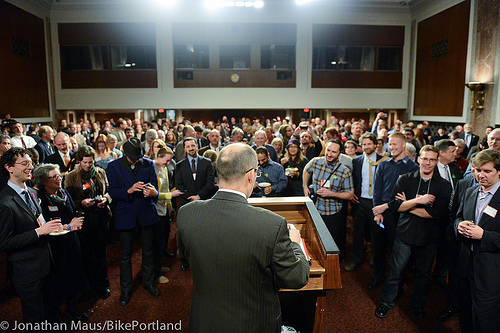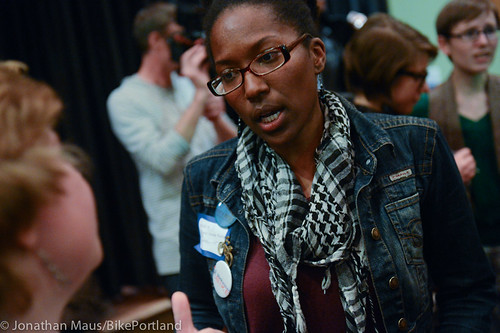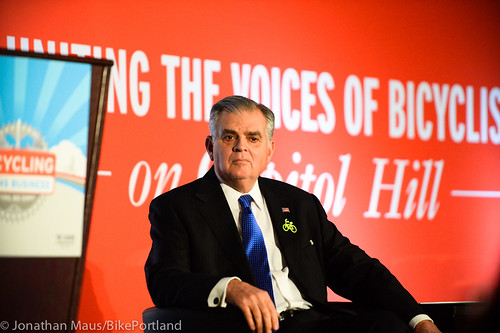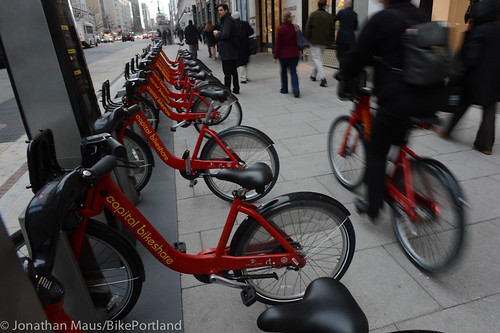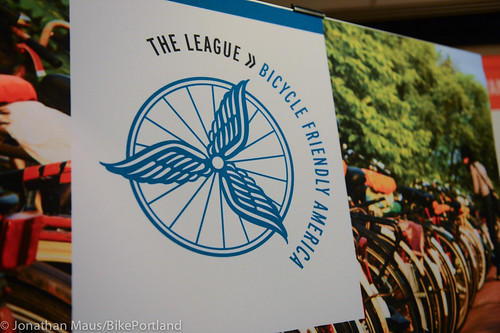
(Photos © J. Maus/BikePortland)
made possible by:
- Planet Bike
- Pro Photo Supply
- Readers like you!
When I first starting thinking about this year’s National Bike Summit, it seemed like it’d be a real dud. With no transportation bill to fight for and a list of “asks” that were frankly, not very exciting, I didn’t have very high expectations. But now, after three and-a-half days of listening and talking as much as my brain would allow, I realize that there’s a lot important stuff going on and I’m glad I was there to be a part of it.
Below are a few themes, tidbits, and personal hunches I took away from the event:
I know I’ve covered this already; but it can’t be said enough how profound of an impact this influx of female energy is for the bike movement. Like I shared exactly one year ago today, the renaissance of women in the bike world started locally and organically. Now, having been wholly accepted by the League of American Bicyclists, the women’s movement has unstoppable momentum.
The vibe in the rooms of the National Women’s Cycling Forum (a League-sponsored event held before the Summit) was electric. Everywhere I turned there were passionate conversations going on, women introducing themselves to each other, and connections being made. I sensed a willingness among women to ask for advice and support from one another that doesn’t exist to the same degree with men. This peer-to-peer strength is just one thing that will make this new vein of the bike movement powerful and transformational.
What does this influx of female energy and ideas mean to the bike movement? It means that bicycling — both as an issue and a cultural phenomenon — will be more accessible, joyful, stylish, and family-oriented. With more women on our side, it makes the case for bicycling much stronger.
In just the past few years there’s been a profound shift in how bicycling is perceived in America. Bicycling has shed much of the cultural baggage that has followed it around for decades. The sport and spandex-focused Lance Armstrong Era is over and it’s been replaced with images of well-dressed men and women using bikes as transportation in cities from Nashville to New York City.
Put another way; bicycling has come of age.
When you have Republicans like Congressman Eric Cantor and Indianapolis Mayor Greg Ballard as bicycle cheerleaders, you know things have changed.
As shown by the work of Douglas Meyer, bicycling now garners much more respect politically and from the general public. And with that respect comes a responsibility for professional advocates and grassroots activists. They must embrace these changes and be willing to change along with them or they risk becoming either 1) ineffective or 2) irrelevant.
The challenge we face is how to balance our seat at the table with the understanding that there’s still a lot of fighting to do. Take it from me, this very complicated; but it’s a good problem to have: I’d rather pound my fist on the table than pound my fist on the door outside hoping someone lets me in.
US DOT Secretary Ray LaHood has had a very good run. His speech at this year’s Summit, his fifth, was also his last (as DOT Secretary at least). (It’s hard to imagine that LaHood’s predecessor didn’t even consider bicycles a transportation mode.) The big news from LaHood was his announcement of two bike safety summits he and US DOT staff plan to convene this spring and summer. The details are still very preliminary; but any time LaHood makes waves about bicycles, it elevates the issue in the eyes of the public and politicians. If he keeps his promise and holds the bike safety summits, it would not only cement his bike-friendly reputation, it would elevate bicycling as a legitimate transportation mode in the eyes of the federal government and the public at large.
It’s also time to look beyond Sec. LaHood. At the Congressional Reception party Wednesday night, I was struck by the ringing endorsement Congressman Earl Blumenauer gave to United States Deputy Secretary of Transportation John Pocari. “If John would consider being Secretary of Transportation,” Blumenauer said, “we couldn’t do better.”
Regardless of who replaces LaHood, I very much doubt we’ll go backwards. LaHood has been a bright spot for Obama and the respect the Secretary has given to bicycles is well-known in the White House. Much like American transportation culture has become less car-centric and more accepting of bicycling in the past few years, so too has the culture at the US DOT. It’s not a question of if the next DOT Secretary will respect bicycling, it’s a question of how hard will they fight for it.
Bike share is arguably the most important thing going for the bike movement right now. Mentions of it as a “game-changer” seeped into many breakout sessions and speeches at the Summit. Thanks in large part to the unbridled success of Capital Bikeshare in DC, bike share has become the manifestation of the case for bicycling. It has shown cities that bicycles offer the best return-on-investment of any transit mode and that bicycles are a popular transportation option with regular people (not just “cyclists”). Bike share also creates the much-needed urgency for local DOTs to design streets with better bike access.
It was an ongoing joke at the Summit that the only time Portland gets mentioned these days is in the context of how, “It’s not just Portland anymore.” Thanks to visionary city leaders, a growing realization of bicycling’s economic impact, and programs like the Green Lane Project, there’s been a proliferation of protected bikeways and other innovative bike facilities in cities all over the country. This was the first Summit I’ve attended where it didn’t feel like Portland was put on a pedestal in every breakout session and speech… And that’s a great thing!
The League unveiled a new logo and re-branding effort at the Summit. It looks great. The graphics are tight and simple and it’s exciting to see the League get a facelift. (My only quibble is that they didn’t purge every mention of “bicyclists” from their identity.) But beyond aesthetics, the League is changing in an even deeper way. “This is not your father’s or your grandfather’s League,” exclaimed League President Andy Clarke on Monday night.
The League’s Equity Advisory Council is forcing them to become more racially diverse and their support of women is helping them tear down the gender barrier. I’ve seen the members of the Equity Council and they are not pushovers. They will expect change at the League and they will force it to happen.
Beyond simply “changing the face of bicycling,” these changes will have another great impact on the League and bicycling in general. The League has struggled for years with an internal debate over vehicular cycling — which advocates education and “taking the lane” versus advocating for physically separated facilities that appeal to riders of all skill levels. The League’s official stance is for protected bikeways; but some board members and other long-time members are staunchly in the vehicular cycling camp.
The League’s embrace of women, people of color, and folks new to bicycling, will result in more members and board members who support protected bikeways. So in some ways, this new influx of members will bolster the ranks of protected bikeway believers and could help the League finally shed its last vestiges of vehicular cycling once and for all.
By the time discussions begin on the next transportation bill (fall of 2014), bicycling will be poised for unprecedented growth. The arguments in favor of more investment and policy attention to bicycling get stronger by the day and its advocates more mature and professional. Combine that with the bipartisan wave of momentum behind bicycling from mayors in cities in every corner of the nation and you have the makings of a bona fide sea change.
If I were an investor in ideas or social movements, I would put a lot of money into bicycling right now.
I hope you enjoyed following our 2013 National Bike Summit coverage. Please give a special thanks to Planet Bike for the financial support that made this trip possible and to Pro Photo Supply for donating rental of some excellent camera equipment. I stayed a few extra days in DC to do some other reporting and some street photography, so stay tuned!
